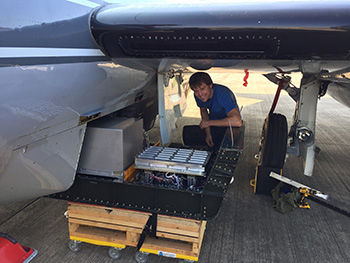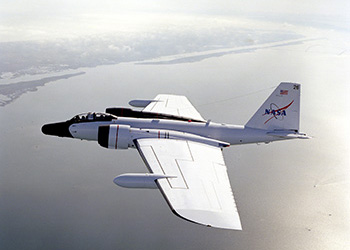A .gov website belongs to an official government organization in the United States.
A lock () or https:// means you've safely connected to the .gov website. Share sensitive information only on official, secure websites.
23 October 2015

Update: The new CSD SO2 instrument was on board as one of the VIRGAS flights flew over Hurricane Patricia above the Pacific Ocean. This hurricane is shaping up to be a Category 5 hurricane and the largest ever recorded in the Western Hemisphere. It is currently moving northward at 10-12 mph and is expected to make landfall later today on the west coast of southern Mexico, bringing 200 mph winds and torrential rains. National Hurricane Center updates are available at //www.nhc.noaa.gov/#PATRICIA
7 October 2015

A new CSD instrument for measuring low concentrations of sulfur dioxide (SO2) high in the atmosphere will take to the skies on October 19 onboard the NASA WB-57F high-altitude research aircraft, kicking off the Volcano-plume Investigation Readiness and Gas-phase and Aerosol Sulfur (VIRGAS) field experiment. In the five science flights of VIRGAS, the aircraft will range north and south of the base location in Houston to make measurements in the upper troposphere and lower stratosphere. In addition to the SO2 instrument, other CSD instruments will measure water vapor and ozone, and instruments from NASA and the University of Miami will measure other sulfur-containing species and meteorological parameters. A research balloon will carry CSD's Printed Optical Particle Spectrometer (POPS) aloft in coordination with one of the WB-57F's flights, to get vertical profiles of the concentrations and sizes of atmospheric fine particles from the ground up into the lower stratosphere.
Why the focus on SO2? Sulfur dioxide plays a principal role in connecting natural and anthropogenic emissions of sulfur species to major environmental issues such as acid rain, aerosol formation, air quality, and climate change. In the stratosphere, sulfur forms the ubiquitous sulfate aerosol layer, which affects climate through scattering and absorption of solar radiation. Various forms of sulfur in the atmosphere, such as dimethyl sulfide and carbonyl sulfide, are converted to SO2 and then to sulfate in the sulfate aerosol layer, making SO2 an especially critical species to measure. Key research issues include understanding how natural and human-caused emissions of sulfur species, for example from volcanoes and from fossil-fuel power sources, ultimately influence climate, air quality, and visibility.
Despite the importance of atmospheric sulfur and specifically SO2 in so many arenas, routine SO2 measurement techniques have not been up to the task because they lack the needed sensitivity in the remote atmosphere, particularly the stratosphere, and are plagued by interferences from other gases. CSD's new SO2 instrument, developed by lead scientist Andrew Rollins and others at CSD, is expected to revolutionize the measurement of SO2 because it remedies both of these problems. The new instrument is based on a novel custom laser system that uses an infrared laser source with fiber-optic amplification to generate intense UV light with a narrow wavelength range. This narrow UV light source is then used in a standard laser-induced fluorescence (LIF) detection cell to measure SO2 with a detection limit 10 times smaller than previous aircraft SO2 instruments and without interferences.

The VIRGAS experiment is a "mini-mission" to test what NASA and NOAA investigators hope will become a new standing capability for measuring SO2, other gases, and particles in the plumes from large volcanic eruptions. The idea is that NASA, partnering with NOAA, would be able to deploy the WB-57F aircraft soon after future volcanic eruptions, giving scientists an unprecedented opportunity to observe the volcanic plume and understand the implications for climate and the atmosphere. It would also provide valuable insight into the implications of proposed mitigation strategies to counter climate warming by deliberate injections of sulfur into the atmosphere. Such injections, like explosive volcanic eruptions, would lead to an augmentation of the sulfate aerosol layer, but their effectiveness and other impacts on the atmosphere (such as damage to the ozone layer) are not certain.
The VIRGAS investigators hope that their measurements will help to characterize the stratospheric sulfate aerosol layer in this non-volcanic time period, and set the stage for new insights when Mother Nature's next volcanic eruption occurs.